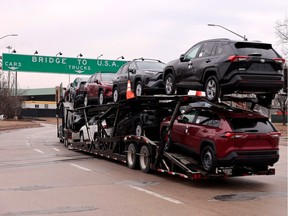If Trump’s tariffs take effect on April 2, prices will likely go up
Article content
U.S. President Donald Trump announced Wednesday that he will be bringing in a 25 per cent tariff on all auto imports at the start of next month. Since many of the parts used in American cars are manufactured in Canada, tariffs could push prices higher, making deals harder to find. The new tariff is set to take effect on April 2 and Trump’s also expected to bring in other reciprocal tariffs that day, which he referred to as “liberation day.” Canada is in the midst of a federal election, and it is unknown if the government will respond with retaliatory tariffs. Liberal Leader Mark Carney is meeting with his Canada-U.S. cabinet committee to discuss a response in Ottawa on Thursday. With more uncertainty ahead, is now the right time to buy a vehicle, or should consumers wait? Here’s everything you need to know.
Advertisement 2
Article content
Are vehicle prices in Canada set to rise?
Fraser Johnson, professor of operations management and director of the Ivey Purchasing Managers Index, says several factors are driving up costs. Existing steel and aluminum tariffs have already added US$1,000 to US$1,500 to the cost of auto parts and vehicles imported from the U.S. and Mexico. If additional auto tariffs are put in place on April 2, prices could rise even more.
“If these tariffs go through, prices could rise by another US$3,000 to US$4,000 while SUVs and trucks could see increases of US$8,000 to US$10,000,” he said. “If these tariffs take effect, car prices will definitely increase.”
For context, the average price for a SUV or truck can range from around $30,000 to $50,000, while the average used price can range from $15,000 to $35,000, depending on factors like make, model, age and condition.
Article content
Advertisement 3
Article content
Buying before tariffs are implemented could help consumers avoid these price hikes.
Does Canada have excess vehicle inventory?
According to Johnson, it depends on the vehicle type.
“There is surplus inventory for some makes and models, but not for all,” he said. “You might find a great deal on a sedan at a Stellantis dealership, but if you’re looking for a Toyota RAV4 Hybrid, you could be waiting six months.”
One segment with a clear surplus is electric vehicles (EVs).
“Car companies committed heavily to EV production and many have overproduced, leading to excess inventory,” Johnson said. “If you’re looking at something like the Ford Mustang Mach-E, you’ll likely find discounts and good financing options.”
After years of shortages, the market has shifted into a buyer’s market as inventory levels have improved.
Can consumers find deals before prices go up?
Advertisement 4
Article content
Yes — if they act soon.
Johnson emphasized that dealerships offer promotions to clear inventory, especially when they have surplus stock.
“If you need a car, now is a good time to shop,” he said. “But you may have to compromise on the make and model to get the best deal.”
According to Car Nation Canada, dealerships adjust pricing throughout the year based on inventory, sales quotas and manufacturer incentives. Some of the best times to shop include:
- End of the month: Dealerships rush to meet sales quotas and may offer discounts to close deals.
- End of the year: Dealers clear out older models to make way for new releases.
- When new models arrive: When new models hit the showroom, dealerships are eager to sell off the older inventory.
- Holiday sales events: Manufacturers often provide special incentives during major shopping periods.
- Discontinued Models: When a vehicle is about to undergo a major redesign, dealerships tend to offer discounts to sell off the outgoing model.
Advertisement 5
Article content
According to Tabangi Motors, if you’re looking for a deal, consider reliable and well-regarded models like Toyota, Honda and Mazda, while avoiding models with poor reliability or high repair costs. They list the top used vehicles in 2025 for reliability and value in Canada as:
- Honda Civic
- Toyota Corolla
- Mazda3
- Hyundai Accent / Elantra
- Kia Soul
- Nissan Sentra
- Subaru Impreza
- Toyota RAV4
- Honda CR-V
How will financing and leasing options change?
If tariffs take effect, automakers may introduce more incentives to keep sales moving.
“This is where we could see 0 per cent financing or cash rebates,” Johnson said. “For example, if you pay cash, you might get a $3,000 rebate. If you finance, you could get 0 per cent interest for five or six years.”
However, he cautioned that higher interest rates have already made financing more expensive. They might not come down to zero.
Advertisement 6
Article content
Here are current car loan rates in Canada — depending on your credit score and loan term:
- New vehicles: Average 3.5 per cent to 7.5 per cent
- Used vehicles: Average 4.5 percent to 10 per cent
What about used car prices?
If new car prices increase, used car prices will follow.
“Used cars are directly impacted by new car pricing,” Johnson said. “If a new Volkswagen Passat increases in price, so will used Passats. It’s basic supply and demand.”
During the COVID-19 pandemic, new car shortages caused record-high used car prices. If tariffs drive up new car costs, demand for pre-owned vehicles will rise, which could drive up prices.
Final advice for car buyers in Canada
With tariffs looming, excess inventory on some models, and dealership incentives available, if you’re in the market for a car, waiting too long could mean higher prices and fewer choices.
“Do your research,” Johnson suggests. “Check inventory levels, compare brand incentives, and look for low-interest financing or cash discounts. There are good deals out there — but you might need to make sacrifices.”
For now, buyers still have a chance to secure a deal before prices rise.
Our website is the place for the latest breaking news, exclusive scoops, longreads and provocative commentary. Please bookmark nationalpost.com and sign up for our daily newsletter, Posted, here.
Article content






